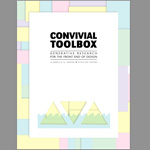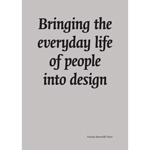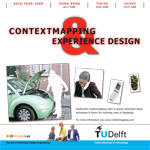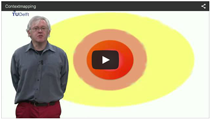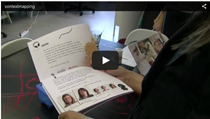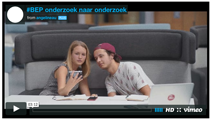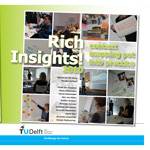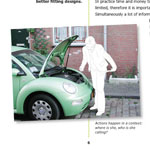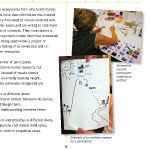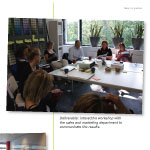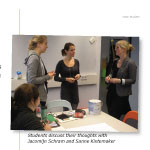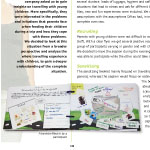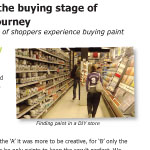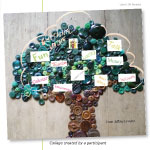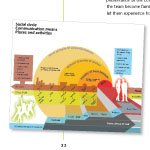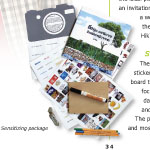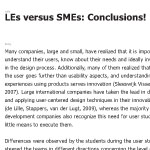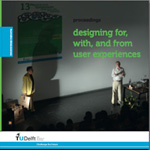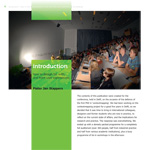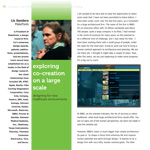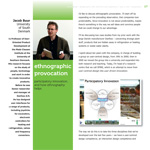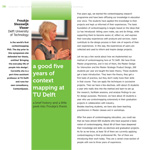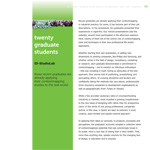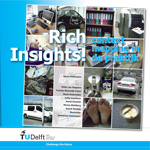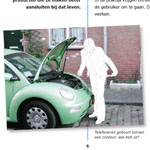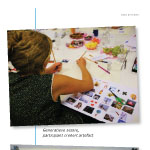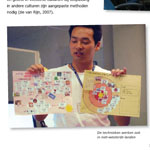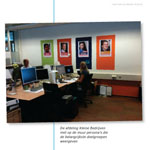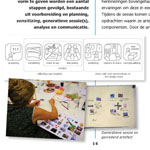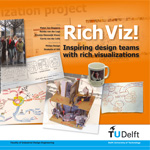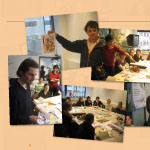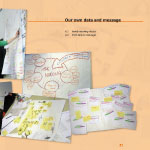How do you do contextmapping? What’s the theory? Which tips and tricks, guidelines have been published? Here’s the shortlist, some videos, and the longlist of what we’ve put out there to help you.
The shortlist: tips and guidelines
The book consists of three parts: basic theory of everyday creativity underlying contextmapping, four cases from practice that show the practicalities of how design research fits into educational and professional practice, and chapters with how-to guidelines for each of the steps in the process.
Sanders L., & Stappers, P. J. (2012). Convivial toolbox: Generative Research for the Front End of Design. BIS Publishers, Amsterdam
This PhD thesis aimed to reach both an academic and a professional audience. It contains a wealth of information: 6 case studies with a focus on the communication phase of contextmapping: how to get the user insights across to the design team. For communication guidelines, see chapter 7.
Sleeswijk Visser, F. (2009). Bringing the everyday life of people into design. TU Delft, Delft University of Technology.
This article introduced the term ‘contextmapping’ and describes the steps in the process, and considerations, from how to create a picture toolset to how to facilitate a session. Cited more than 400 times, it has become the reference description for generative research methods.
Sleeswijk Visser, F. , Stappers, P. J., Van der Lugt, R., & Sanders, E. B. (2005). Contextmapping: experiences from practice. CoDesign, 1(2), 119-149.
This paper shows a clear overview of the different shifts in user-centred design over time. Sanders, L, & Stappers PJ (2014) . ACM Interactions 21(6), 24-33.
As short as it gets: a little brochure that introduces and illustrates the why, what, and how of contextmapping (used in international workshop series in the masterclass format).
The videos
P.J. Stappers introduces the why and what of understanding user needs, and how daily advertisment and professional information sources can stand in the way of recognizing life as it happens out there. (part of Delft Design Approach, MOOC) 2013)
Sanne Kistemaker introduces the how of making generative tools: the path of expression, four steps from facts to values, and how to get started. (part of Delft Design Approach MOOC,2015)
In their Bachelor End Project, students Zoé Martial and Jord de Kat Angelino explain the essence of doing user research to inform your design process; with an emphasis on observation and interviewing techniques. (September 2015)
The longlist
This list presents a collection of our publications related to contextmapping.
2015
Lee, B., Saakes D.P., Sleeswijk Visser, F. Online User Reviews as a Design Resource. In: Proceedings of IASDR 2015, 2-5 Nov 2015 Brisbane, Australia.
Holmlid, S., Mattelmäki, T., Sleeswijk Visser, F., Vaajakallio, K. Co-creative Practices in Service Innovation. Book chapter in The Handbook of Service Innovation, pp 545-574 (2015) Springer.
2014
Crossing Cultural Chasms – towards a culture-conscious approach to design (PhD thesis Annemiek van Boeijen)
Sanders, E. B. N., & Stappers, P. J. (2014). Probes, toolkits and prototypes: Three approaches to making in codesigning. CoDesign, 10(1), 5-14.
Doorn, FAP van, MA Gielen, PJ Stappers (2014) Involving children and elderly in the development of new design concepts to become active together. Interaction Design and Architecture (s), p. 86 – 100.
2013
de Bont et al, Advanced Design Methods for Successful Innovation. Design United 2013. Chapter: Designing for user experiences: contributions from contextmapping. Schifferstein & Froukje Sleeswijk Visser. ISBN 978946186
Doorn, FAP van, Stappers, PJ & Gielen, MA (2013). Design research by proxy: Using children as researchers to gain contextual knowledge about user experience. In WE Mackay (Ed.), Proceedings of the SIGCHI conference on human factors in computing systems CHI ’13 (pp. 2883-2892). New York: ACM.
2012
Alkaya, M., Sleeswijk Visser, F., de Lille, CSH (2012). Supporting NPD teams in innovation: Structuring user data on the foundations of empathy. In Proceedings of the DMI 2012 international design management research conference (pp. 1-8). Boston: DMI.
Stappers, P.J. (2012) Teaching principles of qualitative analysis to industrial design engineers. In: Buck, L, Frateur, G., Ion, W., McMahon, C., Baelus, C, de Grande, G., & Verwulgen, S. (Eds) Design Education for future wellbeing. Proceedings of the 14th International Conference on Engineering & Product Design Education, Antwerp, Belgium, 6-7 September 2012, 109 – 114
van der Lugt, R., Postma, C.E., & Stappers, P.J. (2012) Photoboarding. Touchpoint, 4(2), 76-79.
Postma, C., Creating Socionas (PhD thesis) highlights how we can design for the social relations people have.
van Rijn, H., Meaningful Encounters (PhD thesis) treats methods for designers to learn about and from difficult-to-reach users, such as children with autism.
Sleeswijk Visser, F., de Lille, CSH (2012, oktober 30). Creating an empathic mindset in your organisation. Paris, France, Second service design global conference.
Sleeswijk Visser, F. Manschot, M. Involving users: worth your money? Evaluating the effects of user participation in early stages of service design projects on the outcomes of the design process. (2012) workshop SERVDES
2011
van Rijn, H., Sleeswijk Visser, F., Stappers, P.J. (2011) Stories at the spot: Designers learning from caregivers of children with autism, International Association of Societies of Design Research 2011: Diversity and Unity, 31 October – 4 November 2011, Delft, The Netherlands.
Rijn, H van, Sleeswijk Visser, F, Stappers, PJ & Ozakar, AD (2011). Achieving empathy with users: The effects of different sources of information. CoDesign: international journal of cocreation in design and the arts, 7(2), 65-77.
Mattelmaki, T, Sleeswijk Visser, F. (2011) Lost in co-X: Interpretations of co-design and co-creation. International Association of Societies of Design Research 2011: Diversity and Unity, 31 October – 4 November 2011, Delft, The Netherlands.
Stappers, PJ , Sleeswijk Visser, F & Kistemaker, S (2011). Creation and Co: User participation in design. In B van Abel, L Evers, R Klaassen & P Troxler (Eds.), Open design now: Why design cannot remain exclusive (pp. 140-151). Amsterdam: BIS Publishers.
2010
Rich Insights (2010). In the Rich Insights course, groups of design students carry out a contextmapping study for an industrial company. The first icon opens a pdf of the entire report; the others open a pdf of one chapter each.
van Rijn, H., Sleeswijk Visser, F., Stappers, P.J., Ozakar, A.D., (2010) Understanding users: A comparative study about informing designers by different sources of information, 7th International conference on Design and Emotion, October 4-7, Chicago, USA.
2009
Designing for, with and from user experiences. The symposium celebrated five years of contextmapping research at TU Delft. Speakers are Liz Sanders (chapter 1), Jacob Buur (chapter 2), and Froukje Sleeswijk Visser (chapter 3), and twenty brief CV’s of TU Delft alumni who were in the forefront of contextmapping education, and applied the techniques afterward in their jobs. The first icon opens a pdf of the entire report; the others open a pdf of one chapter each.
Rich Insights (2009). In the Rich Insights course, groups of design students carry out a contextmapping study for an industrial company. The first edition was in Dutch only.
The first icon opens a pdf of the entire report; the others open a pdf of one chapter each.
Sleeswijk Visser, F (2009) Let’s put the knowledge in practice! Proceedings of IASDR, International Association of Societies of Design Research, Seoul, Korea, October 2009
let’s put the knowledge in practice!
Kouprie & Sleeswijk Visser, F (2009) A framework for empathy in design: stepping into and out of the user’s life. Journal of Engineering Design 20(5) 437-448
Stappers, P.J., van Rijn, H., Kistemaker, S., Hennink, A., Sleeswijk Visser, F. (2009)Designing for other people’s strengths and motivations: Three cases using context, visions, and experiential prototypes. Advanced Engineering Informatics, Special Issue on Human-Centered Product Design and Development, 23(2), 174-183.
“Designing for other people≠s strengths and motivations”
2008
Sleeswijk Visser, F and Kouprie, M. Stimulating empathy in ideation workshops Proceedings of Participatory Design Conference, 2008, Indianapolis, p.174-177
2007
Stappers, P.J., Sleeswijk Visser, F. Bringing participatory design techniques to industrial design engineers Engineering and Product Design Education Conference, NewCastle, 2007, 117-122.participatory design in education
Sleeswijk Visser, F., Stappers, P.J. Mind the Face DPPI (Conference on Designing Pleasurable Products and Interfaces), Helsinki, 2007, 119-134. mind the face
Sleeswijk Visser, F., Stappers, P.J. Who includes user experiences in large companies? International conference on inclusive design, Royal College of Art, London, UK, April 2007, 1-5. who includes user experiences?
Stappers, P.J., Sleeswijk Visser, F. Teaching contextmapping to industrial design students International conference on inclusive design,Royal College of Art, London, UK, April 2007, 1-10. teaching contextmapping
van der Lugt, R., Sleeswijk Visser, F. Creative sessions for interpreting and communicating rich user information International conference on inclusive design Royal College of Art, London, UK, April 2007, 1-5. creative sessions
Sleeswijk Visser, F., van der Lugt, R., Stappers, P.J. Sharing user experiences in the product innovation process: Participatory design needs participatory communication. Journal of Creativity and Innovation Management, 16(1), 2007, 35-45. sharing user experiences
van Rijn, H & Stappers, PJ (2007). Getting the shy to talk: scripts and staging for contextmapping. In J Myerson, C Bilsland & JA Bichard (Eds.), Include Conference Proceedings (pp. 1-5). London: Royal College of Art.
2006
van Rijn, H, Bahk, Y, Stappers, PJ & Lee, KP (2006). Three factors for contextmapping in East Asia: Trust, control and nunchi. CoDesign: international journal of cocreation in design and the arts, 2(3), 157-177.
Stappers, P. J. (2006). Creative connections: user, designer, context, and tools. Personal and ubiquitous computing, 10(2-3), 95-100.
Stappers, PJ & Sleeswijk Visser, F (2006). Contextmapping. GEO: Connexion, 5(7), 22-24.
2005
Sleeswijk Visser, F., van der Lugt, R., Stappers, P.J. Participatory design needs participatory communication. Proceedings of the 9th European Conference on Creativity and Innovation, Lodz, Poland, 2005, 173-195. participatory communication
Van der Lugt, R., Sleeswijk Visser, F. Widening involvement in creative group processes: What we learned from cultural probes. Proceedings of the 9th European Conference on Creativity and Innovation, Lodz, Poland. 2005 widening involvement
Sleeswijk Visser, F., Visser, V., Re-using users: Co-create and co-evaluate.Personal and ubiquitous computing, 10(2-3), 2005, 148-152. re-using users
RichViz! was an elective course focusing on methods and media to convey findings from user studies. This project was conducted in collaboration with Philips Design. The first icon opens a pdf of the entire report; the others open a pdf of one chapter each.




